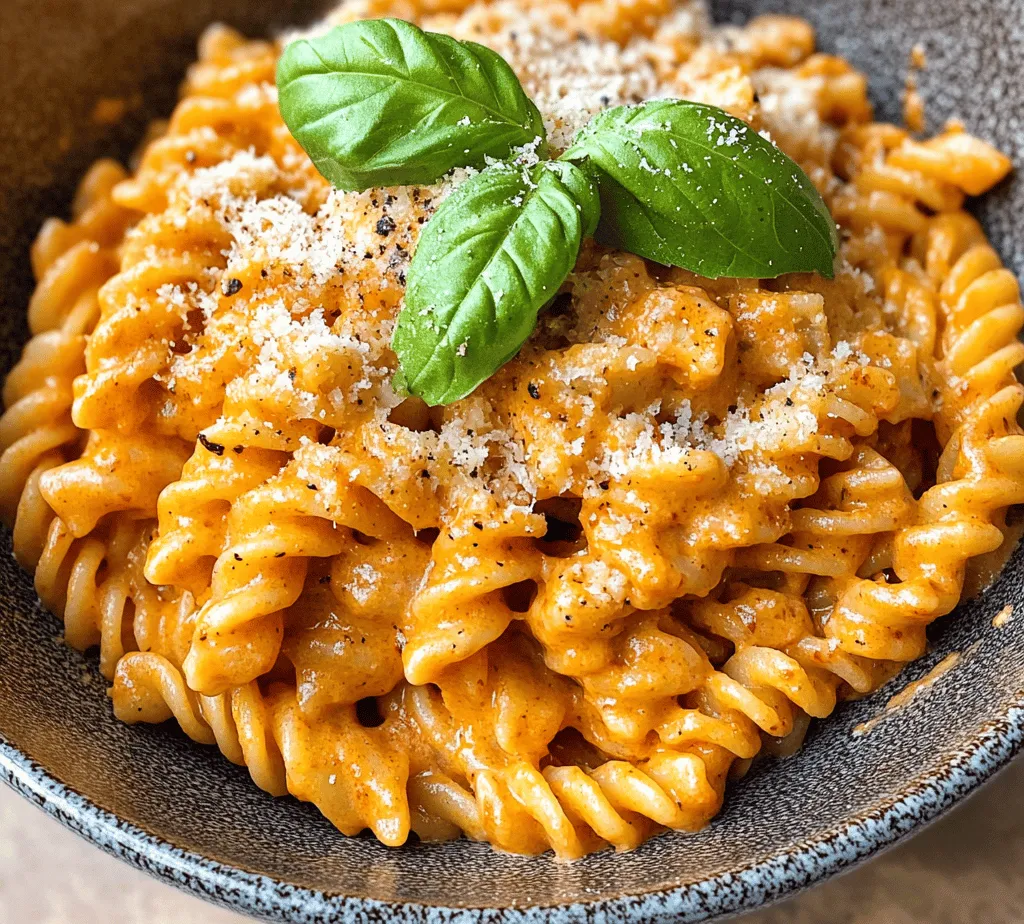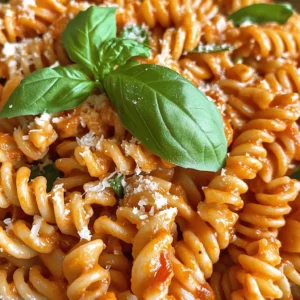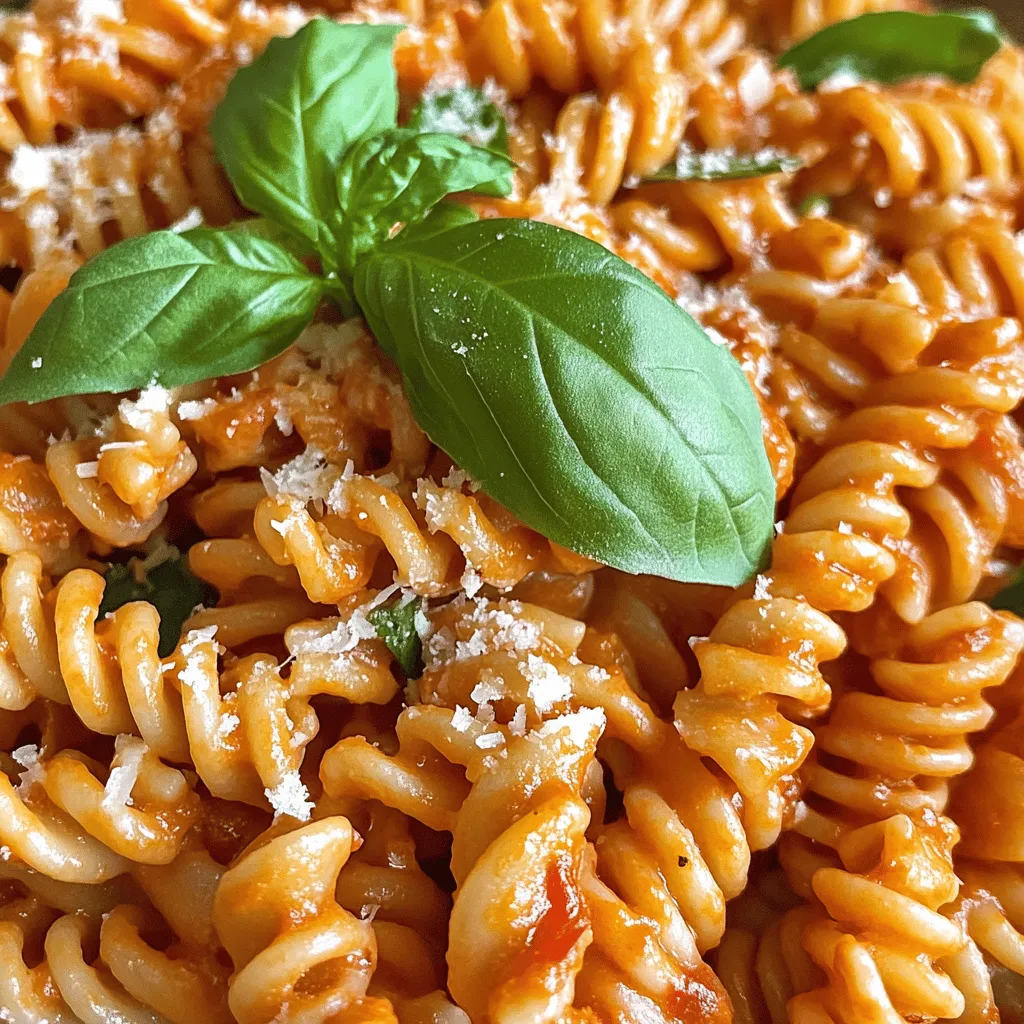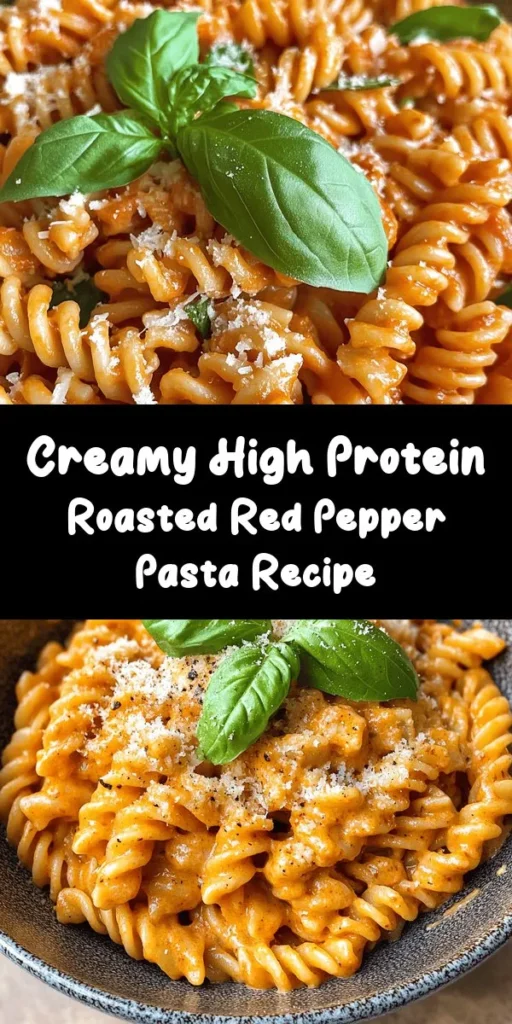Introduction
If you’re on the lookout for a dish that embodies both flavor and nutrition, look no further than High Protein Creamy Roasted Red Pepper Pasta. This delightful meal combines the rich, robust taste of roasted red peppers with the creamy texture of a yogurt-based sauce, creating a pasta experience that is both indulgent and wholesome. As more people seek to incorporate high-protein meals into their diets, this recipe serves as a perfect solution, delivering a satisfying balance of taste and nutrition.
High-protein meals are essential in a balanced diet, especially for those looking to build muscle, maintain energy levels, or simply enjoy a more filling meal. Protein plays a vital role in the body’s repair processes and helps keep you satiated longer, making it a crucial component of any meal. With this recipe, you can easily increase your protein intake while savoring every bite.
This dish shines not only for its taste but also for its nutritional value. By using wholesome, natural ingredients, you can enjoy a creamy, flavorful pasta that aligns with your health goals. The main components of this recipe include whole grain pasta, roasted red peppers, Greek yogurt, and Parmesan cheese, each contributing unique flavors and health benefits. Let’s take a closer look at these ingredients and their nutritional advantages before diving into the cooking process.
Understanding the Ingredients
Whole Grain Pasta: Nutritional Benefits and Why to Choose Whole Grain
When it comes to pasta, choosing whole grain over its refined counterpart can significantly boost your meal’s health profile. Whole grain pasta retains the bran and germ of the wheat, meaning it’s packed with fiber, vitamins, and minerals. This fiber content not only aids in digestion but also helps regulate blood sugar levels, keeping you full longer. Additionally, whole grain pasta provides essential nutrients such as B vitamins, iron, and magnesium, making it a superior choice for those aiming for a balanced diet.
Roasted Red Peppers: Flavor Profile and Health Benefits
Roasted red peppers are a star ingredient in this dish, offering a sweet and smoky flavor that elevates the entire meal. Beyond their delightful taste, these peppers are rich in vitamins A and C, both of which are important for maintaining healthy skin, vision, and immune function. Their vibrant color also indicates a high level of antioxidants, which can help combat oxidative stress in the body. Incorporating roasted red peppers into your pasta not only enhances the flavor but also boosts the nutritional value.
Greek Yogurt: High Protein Content and Its Role in the Sauce
Greek yogurt serves as the creamy base for this pasta sauce, providing a rich texture without the excess calories and fat typically associated with heavy creams. One of the standout features of Greek yogurt is its impressive protein content, which is often double that of regular yogurt. This makes it an excellent choice for those looking to up their protein intake. Additionally, Greek yogurt contains probiotics, which support gut health and digestion. By blending it into the sauce, you achieve a creamy consistency while infusing your dish with valuable nutrients.
Parmesan Cheese: Adding Richness and Flavor While Providing Protein
Parmesan cheese is another key player in this recipe, contributing both flavor and an additional protein boost. Known for its nutty and savory profile, Parmesan enhances the overall taste of the dish, making it irresistibly delicious. It is also a good source of calcium, which is essential for bone health. When added to the sauce, Parmesan cheese melts beautifully, creating a rich, creamy texture that binds the flavors together.
Broth: Enhancing Flavor While Keeping the Dish Light
Using broth in the sauce not only adds depth to the flavor profile but also helps to maintain a lighter consistency. Opting for a low-sodium vegetable or chicken broth allows you to control the salt content while still achieving a rich taste. The broth’s liquid component enables the sauce to coat the pasta evenly, ensuring every bite is flavorful without being heavy.
Garlic: Health Benefits and Flavor Enhancement
Garlic is a staple ingredient in countless recipes, and for good reason. It adds a punch of flavor and aroma to the dish while offering numerous health benefits. Garlic is known for its anti-inflammatory and antioxidant properties and may help support heart health and boost the immune system. In this recipe, sautéing minced garlic in olive oil before adding it to the sauce enhances its natural sweetness and enriches the overall flavor profile.
Olive Oil: Importance of Healthy Fats in Cooking
Olive oil is a cornerstone of Mediterranean cooking and is well-regarded for its health benefits. Rich in monounsaturated fats, it can help lower bad cholesterol levels and reduce the risk of heart disease. Additionally, olive oil is packed with antioxidants and anti-inflammatory properties. In this recipe, it serves as the cooking fat for sautéing garlic and contributes to the creamy texture of the sauce when blended with Greek yogurt.
Optional Protein Add-Ins: Benefits of Chicken and Chickpeas
For those looking to increase the protein content even further, consider adding chicken or chickpeas. Grilled or sautéed chicken can provide lean protein, helping to make the dish even more filling and nutritious. Alternatively, chickpeas offer a plant-based protein option that also adds fiber and texture to the pasta. Both options allow for customization based on dietary preferences while enhancing the dish’s overall appeal.
Step-by-Step Cooking Instructions
Cooking the Pasta: Importance of Al Dente Texture and How to Achieve It
To start, bring a large pot of salted water to a rolling boil. When cooking pasta, it’s important to follow the package instructions for timing; however, aiming for an al dente texture is key. Al dente, meaning “to the tooth” in Italian, allows the pasta to maintain a slight firmness when bitten into, providing a delightful contrast to the creamy sauce.
Once the water is boiling, add the whole grain pasta and stir occasionally to prevent sticking. Check the pasta a minute or two before the suggested cooking time to ensure it reaches that perfect al dente state. Once ready, reserve about a cup of the pasta water before draining the pasta in a colander. This starchy water can be used later to adjust the sauce’s consistency, making it creamier and ensuring it clings beautifully to the pasta.
Preparing the Sauce: Blending Techniques for a Creamy Consistency
While the pasta is cooking, it’s time to prepare the roasted red pepper sauce. Start by heating a tablespoon of olive oil in a medium-sized skillet over medium heat. Add minced garlic and sauté until fragrant, about 30 seconds. Be careful not to let it burn, as this can impart a bitter taste to the sauce.
Next, add the roasted red peppers to the skillet and stir to incorporate the garlic. If you’re using jarred roasted red peppers, ensure they are drained well to avoid excess moisture. Allow the mixture to cook for a few minutes, letting the flavors meld together. Once heated through, transfer the roasted red pepper and garlic mixture to a blender.
Add Greek yogurt, grated Parmesan cheese, and a splash of the reserved pasta water to the blender. Blend until smooth and creamy, adjusting the consistency with more pasta water as needed. The sauce should be rich and velvety, perfect for coating the pasta. Taste and season with salt and pepper to your liking, ensuring that the flavors are balanced and to your preference.
This step sets the stage for a luscious, high-protein meal that delights the senses. Now that the pasta is cooked to perfection and the sauce is blending beautifully, you’re well on your way to enjoying a nourishing and delicious dinner.
Stay tuned for the next part of this recipe, where we will combine the pasta and sauce, add optional protein enhancements, and finalize this incredible dish.

Heating the Sauce
When it comes to heating the creamy roasted red pepper sauce, the goal is to achieve a warm, inviting dish without compromising the flavors or texture. Here are some tips to ensure even heating without overcooking:
1. Use Low Heat: Start by placing the sauce in a saucepan over low to medium heat. This allows the ingredients to warm slowly and evenly, preventing the risk of burning or curdling the cream if used.
2. Stir Frequently: As the sauce heats, stir it frequently with a wooden spoon or spatula. This not only helps in distributing the heat evenly but also prevents the sauce from sticking to the bottom of the pan.
3. Add a Splash of Water or Broth: If the sauce appears too thick while heating, consider adding a small splash of water or vegetable broth. This will help loosen the sauce, making it easier to coat the pasta later.
4. Check for Temperature: Use a food thermometer if you’re unsure about the temperature. Aim for around 165°F (74°C) to ensure the sauce is heated through but not boiling, which can alter its creamy consistency.
Combining Pasta and Sauce
Once your pasta is perfectly cooked and drained, it’s time to bring together the pasta and the creamy roasted red pepper sauce. Here are some techniques for optimal sauce coverage:
1. Reserve Pasta Water: Before draining your pasta, reserve about a cup of the pasta cooking water. This starchy water can be added to the sauce later to help it adhere to the pasta better.
2. Toss in the Sauce: In a large mixing bowl or directly in the saucepan, add the hot pasta to the heated sauce. Use tongs or a spatula to gently toss the pasta with the sauce, ensuring every strand is coated.
3. Incorporate Pasta Water: If the sauce seems too thick, gradually add small amounts of the reserved pasta water, stirring continuously until you reach your desired consistency. This not only helps the sauce stick but also enhances the overall flavor.
4. Let it Rest: After combining the pasta and sauce, allow the dish to rest for a few minutes off the heat. This short time lets the sauce cling to the pasta, ensuring every bite is creamy and flavorful.
Adding Extra Protein
For those looking to boost the protein content of this dish, incorporating chicken or chickpeas is a fantastic option. Here’s how to do it effectively:
1. Chicken: If you choose to add chicken, consider using grilled or sautéed chicken breast. Cook the chicken separately with seasonings of your choice (such as garlic powder, paprika, and Italian herbs) until it reaches an internal temperature of 165°F (74°C). Slice the chicken into bite-sized pieces and gently fold it into the pasta and sauce mixture just before serving.
2. Chickpeas: For a plant-based protein option, canned chickpeas work wonderfully. Rinse and drain the chickpeas before adding them to the sauce while it’s heating. This allows them to warm up and absorb some of the sauce’s flavor. Aim for about one cup of chickpeas for a protein-rich addition.
3. Other Protein Options: You can also experiment with shredded rotisserie chicken, turkey, or even tofu for a vegetarian option. Each of these can elevate your dish while providing the protein punch you desire.
Nutritional Analysis
Understanding the nutritional content of your high protein creamy roasted red pepper pasta can help you make informed dietary choices. Here’s a detailed breakdown:
1. Protein Content: Each serving of this dish, assuming the addition of chicken or chickpeas, can provide approximately 25-30 grams of protein. This aligns perfectly with daily protein intake recommendations, especially for active individuals.
2. Caloric Information: A standard serving of this pasta (with sauce and chicken) contains around 450-600 calories, depending on the specific ingredients used. This calorie count fits well into a balanced diet, especially when paired with a side of vegetables or a light salad.
3. Comparison with Traditional Creamy Pasta Dishes: Traditional creamy pasta dishes often contain much higher fat and calorie content due to heavy cream and cheese. In contrast, this high-protein version offers a healthier alternative without sacrificing taste, making it a more nutritious choice for pasta lovers.
Flavor Variations and Customizations
One of the joys of cooking is the opportunity to customize recipes to suit your palate. Here are some flavor variations and customizations for this creamy pasta:
1. Additional Spices or Herbs: Enhance the flavor profile of your dish by adding spices like red pepper flakes for heat or smoked paprika for a deeper flavor. Fresh herbs such as basil, parsley, or thyme can add a vibrant freshness to the dish.
2. Lactose-Free or Vegan Options: For a lactose-free version, substitute traditional cream with coconut cream or a cashew cream blend. For a vegan alternative, replace chicken with chickpeas or sautéed mushrooms, and ensure the pasta used is egg-free.
3. Creative Serving Ideas: This creamy pasta can also serve as a base for salads. Consider tossing it with fresh spinach, arugula, or cherry tomatoes for a refreshing twist. Alternatively, use the pasta as a filling for stuffed peppers or as a layer in a baked casserole.
Storage and Reheating Tips
Storing and reheating your creamy roasted red pepper pasta properly ensures that you can enjoy leftovers without compromising on taste or texture. Here’s what to do:
1. Best Practices for Storing Leftovers: Allow any leftovers to cool completely before transferring them to an airtight container. Store in the refrigerator for up to 3 days. For longer storage, consider freezing the pasta in a freezer-safe container for up to 3 months.
2. Reheating Without Sacrificing Texture and Flavor: When reheating, avoid the microwave if possible, as it can lead to uneven heating and a rubbery texture. Instead, gently reheat on the stovetop over low heat, adding a splash of water or broth to the pan to help rehydrate the sauce. Stir frequently until warmed through.
Conclusion
The high protein creamy roasted red pepper pasta is not only a delicious meal but also a nutritious option packed with flavor and versatility. With its robust protein content and lower calorie count compared to traditional creamy pasta dishes, it’s a dish you can feel good about serving to your family.
Encourage experimentation with various spices and proteins to personalize the dish to your liking. Whether it becomes a staple for busy weeknights or a delightful meal for special occasions, this pasta recipe has the potential to become a family favorite.
Incorporating high-protein meals into your cooking repertoire can significantly enhance your dietary habits, making it easier to maintain a balanced lifestyle. Enjoy the journey of discovering new variations and savoring the rich flavors this dish has to offer.



